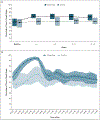A Randomized Trial of Closed-Loop Control in Children with Type 1 Diabetes
- PMID: 32846062
- PMCID: PMC7920146
- DOI: 10.1056/NEJMoa2004736
A Randomized Trial of Closed-Loop Control in Children with Type 1 Diabetes
Abstract
Background: A closed-loop system of insulin delivery (also called an artificial pancreas) may improve glycemic outcomes in children with type 1 diabetes.
Methods: In a 16-week, multicenter, randomized, open-label, parallel-group trial, we assigned, in a 3:1 ratio, children 6 to 13 years of age who had type 1 diabetes to receive treatment with the use of either a closed-loop system of insulin delivery (closed-loop group) or a sensor-augmented insulin pump (control group). The primary outcome was the percentage of time that the glucose level was in the target range of 70 to 180 mg per deciliter, as measured by continuous glucose monitoring.
Results: A total of 101 children underwent randomization (78 to the closed-loop group and 23 to the control group); the glycated hemoglobin levels at baseline ranged from 5.7 to 10.1%. The mean (±SD) percentage of time that the glucose level was in the target range of 70 to 180 mg per deciliter increased from 53±17% at baseline to 67±10% (the mean over 16 weeks of treatment) in the closed-loop group and from 51±16% to 55±13% in the control group (mean adjusted difference, 11 percentage points [equivalent to 2.6 hours per day]; 95% confidence interval, 7 to 14; P<0.001). In both groups, the median percentage of time that the glucose level was below 70 mg per deciliter was low (1.6% in the closed-loop group and 1.8% in the control group). In the closed-loop group, the median percentage of time that the system was in the closed-loop mode was 93% (interquartile range, 91 to 95). No episodes of diabetic ketoacidosis or severe hypoglycemia occurred in either group.
Conclusions: In this 16-week trial involving children with type 1 diabetes, the glucose level was in the target range for a greater percentage of time with the use of a closed-loop system than with the use of a sensor-augmented insulin pump. (Funded by Tandem Diabetes Care and the National Institute of Diabetes and Digestive and Kidney Diseases; ClinicalTrials.gov number, NCT03844789.).
Copyright © 2020 Massachusetts Medical Society.
Figures

Comment in
-
Control-IQ technology enhanced by educative path in diabetes children.Diabetes Res Clin Pract. 2020 Nov;169:108525. doi: 10.1016/j.diabres.2020.108525. Epub 2020 Oct 29. Diabetes Res Clin Pract. 2020. PMID: 33129911 No abstract available.
-
A Randomized Trial of Closed-Loop Control in Children with Type 1 Diabetes.N Engl J Med. 2020 Dec 17;383(25):2484. doi: 10.1056/NEJMc2030417. N Engl J Med. 2020. PMID: 33326730 No abstract available.
References
-
- American Diabetes Association. 13. Children and adolescents: Standards of Medical Care in Diabetes–2020. Diabetes Care 2020;43:Suppl 1:S163–S182. - PubMed
-
- DeBoer MD, Breton MD, Wakeman C, et al. Performance of an artificial pancreas system for young children with type 1 diabetes. Diabetes Technol Ther 2017;19:293–8. - PubMed
-
- Hovorka R, Allen JM, Elleri D, et al. Manual closed-loop insulin delivery in children and adolescents with type 1 diabetes: a phase 2 randomised crossover trial. Lancet 2010;375:743–51. - PubMed
-
- Phillip M, Battelino T, Atlas E, et al. Nocturnal glucose control with an artificial pancreas at a diabetes camp. N Engl J Med 2013;368:824–33. - PubMed
Publication types
MeSH terms
Substances
Associated data
Grants and funding
LinkOut - more resources
Full Text Sources
Medical
